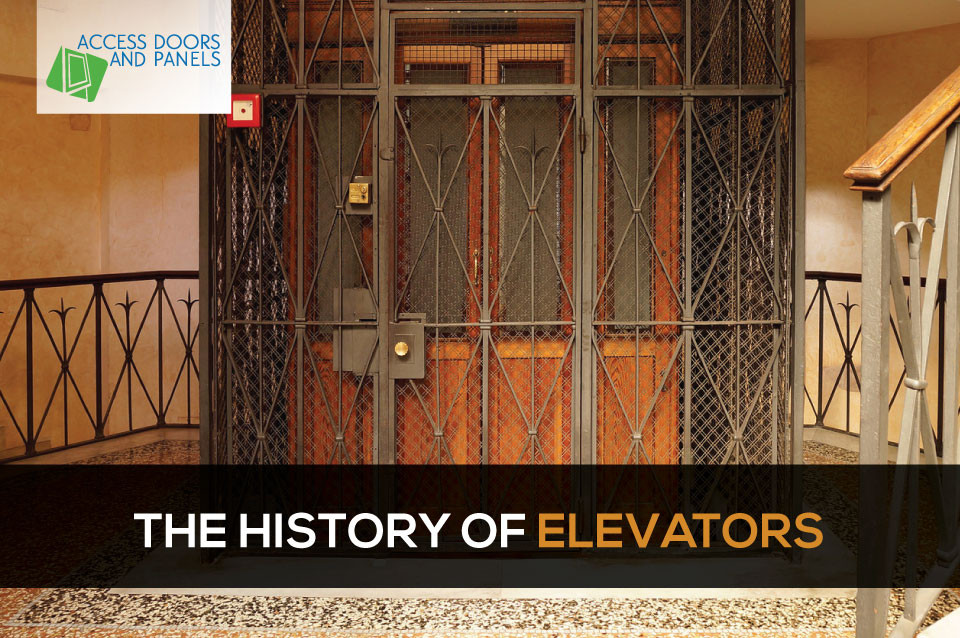The History of Elevators
Posted by Access Doors and Panels on 25th Aug 2021
Humanity has always been innovative in finding creative ways when it comes to improving efficiency. Humans have been looking for a mechanism to transport freight and passengers vertically to different levels since the beginning. First elevators are these gadgets that lift objects up and down.
Interesting Read: " Innovations in High-Rise Building Designs."
Most people don't pay much thought to how elevators work or how they grew so prevalent before becoming familiar with most buildings. Elevators are intriguing technological marvels that have a lengthy history.
Early History
The history of elevators dates back many hundred years before Christ. The first elevators were known as hoists. To power these mechanisms, early humans used their physical strength and animal power, and water-driven systems. These mechanisms have been around since the 3rd century BC. People use this system for over 2000 years.
Several mountain monasteries employed miniature "basket" elevators to convey people and things up their high and solitary walls throughout the Middle Ages. Those constructed monasteries have no land access and only an elevator as a means of admittance.
King Louis XV of France in 1743 had the first human-powered, counter-weighted personal elevator built. It linked his Versailles apartment to his mistress, Madame de Chateauroux, who lived one floor above him. In 1793, a Russian mechanic and inventor invented the first elevator, which used screw mechanisms to hoist the cabin. The installation of his elevators is in two Russian imperial palaces, St. Petersburg and Moscow, and in London thirty years later.
The Advent of Change
The invention of hydraulic and electrical power ushered in a revolution in elevator technology. Hydraulic elevators were the most popular mode of transportation for freight commodities over short vertical distances. They worked on increasing the pressure of the primary plunger, which drove the freight compartment upwards.
Elevator technology advanced dramatically in the nineteenth century. Many elevators in warehouses, mines, and factories powered by steam became vital throughout the Industrial Revolution to allow people to transfer heavy products. These primitive elevators gradually progressed from smoke to hydraulic power. They use water pressure as the source of energy for the earliest hydraulic elevators.
Burton and Hormer, two architects, erected an "ascending room" in 1823 to provide tourists a panoramic perspective of London. The "Teagle," a steam-powered belt-driven and counter-weighted elevator, was built in England by Frost and Stutt, who were also architects, in 1835. Sir William Armstrong invented the hydraulic crane in 1846. A massive piston that moved in a cylinder supported the system. The mechanism's power is by oil or water pressure inside the pump.
Elevator design, the ones we used until this day, dates back to 1852 when a safety system kept the cabin from plummeting if the main cable failed. Elisha Graves Otis, the inventor of this gadget, demonstrated in the New York Crystal Palace exposition of technical achievements in 1854. His elevator was put in the first skyscraper in New York City a few years later.
Otis founded an elevator manufacturing company, which went on to dominate the elevator industry. The Otis Elevator Factory is now the world's largest vertical transportation system manufacturer.
Elevator Technology Revolution
The invention of hydraulic and electrical power ushered in a revolution in elevator technology. Electricity quickly became the recognized source of energy as motor technology and control systems advanced. These elevators' safety and speed improved considerably. Wener Von Siemens, a German inventor, created the first electric elevator in 1880.
In 1887, issuing a patent for an electric elevator with automatic doors that would block off the elevator shaft happened. Elevators became safer due to this development, and the erection of the first commercially practical electric elevator occurred in 1889. During World War II, significant developments in electronic systems led to many modifications in elevator design and installation.
Conclusion
Multiple elevators with a unified control system are prevalent in today's business buildings. Furthermore, all modern elevators feature unique override settings that allow elevators to proceed straight to a designated floor without stopping. In many nations nowadays, there are many regulations for the usage of elevators in multi-story buildings.
In addition, modern elevators also have additional safety and convenient features like fire-rated access panels for all surfaces installed on the elevator's ceiling for ease of access for maintenance and emergencies. This feature can function as an escape hatch if people get trapped inside the elevator. Be sure to install access panels in your elevators!

